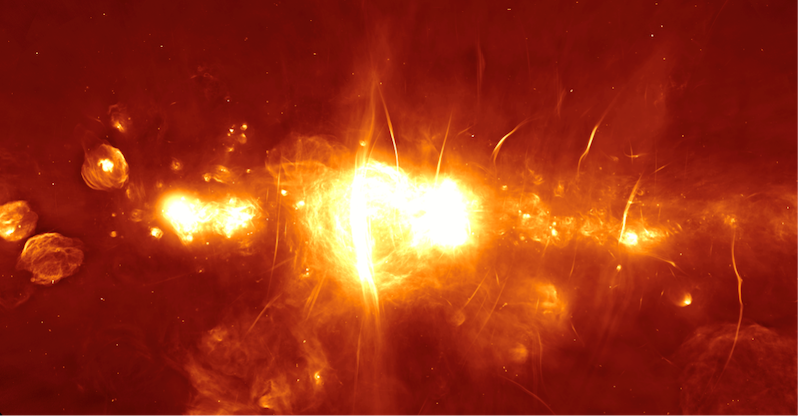 Earth & Space
Earth & Space
Our Galaxy is shooting out bullets of cold gas
Using modern radio-telescopes, we found that the Milky Way expels large amounts of dense, cold gas from its central regions through a powerful galactic wind. Although we don’t understand well this phenomenon yet, it may shape the future life of our Galaxy as it removes the material needed to form the next generation of stars.

The central regions of disk galaxies are large-scale powerhouses. Galactic nuclei usually host super-massive black holes that release huge amounts of energy when matter spirals around them and eventually falls onto them. Many galaxies also show strong star formation activity in their inner regions, with young massive stars frequently exploding as powerful supernovae. All the energy produced by black holes and star formation blasts away interstellar gas and drives it out of the galactic disk at a hundred kilometres per second velocities. We know that this kind of process, that we call “galactic wind”, happens in many star-forming galaxies in the Universe and we believe it may play a major role in their evolution.
In the early 2000s, astronomers discovered that our own Galaxy, the Milky Way, also has a large-scale galactic wind that originates from its nucleus, giving us the unique opportunity to study these phenomena with a level of detail unachievable with other galaxies. Using special telescopes (that use X-ray and γ-ray), researchers discovered two giant lobes - called “the Fermi Bubbles” - filled with blazing gas at temperatures of several million Celsius degrees escaping from our Galaxy at a thousand kilometres per second. These huge bubbles extend as far as 30,000 light years away from the Galactic center. They derive from the combined action of our central super-massive black hole, which weights around 4 million times our Sun, and the violent star formation in the innermost 500 light years of our Galaxy.
We have recently discovered that, beside this blazing gas, our Galaxy is also expelling a significant amount of colder and denser gas. The identification of this new type of gas in the Milky Way’s galactic wind was made possible thanks to two of the world’s most advanced radio-telescopes: the Green Bank Telescope in the USA and the Atacama Pathfinder EXperiment in Chile. These telescopes can “see” the coldest matter in the Universe, with temperatures as cold as -260 Celsius degrees - only a handful of degrees above the absolute zero. In particular, we have detected neutral hydrogen gas (the most abundant chemical element in the Universe) and carbon monoxide, a gas extremely common in the chilliest places of our Galaxy.
The above-mentioned telescopes revealed for the first time the presence of numerous cloudlets of cold gas immersed in a hot, high-speed outflow that drags these dense clouds. The existence itself of these clouds is puzzling: it is easy and intuitive to imagine that a cold cloud in contact with a gas a million times hotter should evaporate quickly, just like an ice cube would instantaneously melt in hot water. Another mystery is how this chilly gas got there: while hot gas is light and easy to move around, cold and dense gas is heavy and problematic to accelerate. Try to move a bowling ball with a breath: it requires a lot of effort! It is not clear yet how our Galaxy is releasing enough energy to push this dense matter out.
A very important aspect of this cold gas outflow is the effect that it may have on the future life of our Galaxy. We have estimated that the Milky Way expels the equivalent in mass of our Sun every 10 years, but it also uses this cold and dense gas to assemble new stars. If the Milky Way continues to lose such large quantities of this gas because of the nuclear wind, we can imagine that at some point it will run out of the fuel needed to form new stellar systems, at least in the inner regions.
In conclusion, our discovery of the Milky Way’s cold outflow opens up a new window on the physical processes that occur within galactic winds, but it also raises more questions than answers. We are still a long way from a complete understanding of these fascinating phenomena and their role in the history of the Universe, but new observations from forefront telescopes pledge to revolutionise our view on how galaxies assemble and evolve throughout cosmic time.
Original Article:
Di Teodoro, E., McClure-Griffiths, N., Lockman, F. & Armillotta, L. Cold gas in the Milky Way’s nuclear wind. Nature 584, 364-367 (2020).Edited by:
Dr. Margaux Héritier , Senior Scientific Editor
We thought you might like
The stars that time forgot remember the youth of our Milky Way
Mar 12, 2021 in Earth & Space | 4 min read by Geraint F. LewisMore from Earth & Space
Discovery of the first radiation belt beyond the Solar System
Jan 27, 2025 in Earth & Space | 3.5 min read by Juan Bautista Climent OliverOne million (paper) satellites
Jan 24, 2025 in Earth & Space | 3 min read by Ewan Wright , Andrew FalleVolcanic Ash: A Nutrient Boost for Reef-Building Corals
Sep 18, 2024 in Earth & Space | 4 min read by Frank Förster , Tom SheldrakeAmmonia Energy: A Call for Environmental Awareness
Aug 29, 2024 in Earth & Space | 3.5 min read by Matteo Bertagni , Robert Socolow , Amilcare PorporatoLikely increase in coral thermal tolerance at a Pacific archipelago
Dec 29, 2023 in Earth & Space | 3 min read by Liam LachsEditor's picks
Trending now
Popular topics


